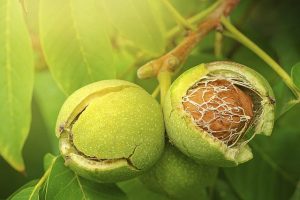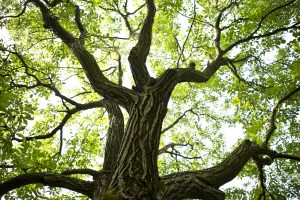When I think of black walnuts, I think of their abscission layer. Abscission is a botanical term used to describe the highly complex separation of leaves, flowers, and fruits from their respective plants at the end of the growing season. In a nutshell, our deciduous trees produce hormones to inhibit growth and promote dormancy, resulting in leaves and nuts falling off before winter sets in.
Compared with other common trees, abscission in black walnut trees occurs early. Walnuts will drop their leaves after the first cold snap in mid to late September. They hang on to their big green nuts a tad longer.
Our Local Giants
Black walnuts are fine looking trees; their thick dark bark is deeply furrowed. These giants will often exceed 100 feet in height in forest settings. It is easy to spot their long, pinnately compound leaves holding 15 – 23 lance shaped, lime-colored leaflets. The dark heartwood  from walnut trees is durable, attractive, and highly prized by woodworkers. As previously mentioned, their nuts are sizable (plum sized) and covered with an aromatic, thick green husk.
from walnut trees is durable, attractive, and highly prized by woodworkers. As previously mentioned, their nuts are sizable (plum sized) and covered with an aromatic, thick green husk.
Black walnuts are valuable to wildlife, providing plenty of important food sources for larval insects, insectivores and rodents. Our gray and fox squirrels possess the tools necessary to crack the walnut’s tough shell: sharp incisors and rock-hard molars. They rotate the walnut in their little paws and gnaw at the husk as it spins. Eventually the nut cracks and the sweet nut meat can be accessed.
Domineering Neighbors
Black walnuts are a force of nature in their neighborhoods. They control which plants can live next door. They’re notorious for exhibiting serious allelopathic tendencies; that is, walnut roots and leaflets contain a chemical – juglone – that inhibits plant germination and growth from some of their neighboring flora. Compare the plants growing under black walnut trees with those under other mature hardwoods and you should spot a distinction.
Keep your eyes on your favorite walnut tree over the next few weeks. Soon it will be a bare tree with big green nuts.
By the way, abscission is a favorite word among the spelling bee crowd.




Hi Fox River Friends,
I measured what I think could be an Illinois State record Black Walnut in the Ferson Creek Bottoms near the Fox River. Over 5’ in diameter,
110’ tall, with a 100’ spread. A majestic tree worthy of Sherwood Forest!
I discovered the river a year ago with kayak, and then canoe, and then rowboat. The areas of open forests, sandy beaches and large sea shells with huge squaking birds overhead cause me to realize how old and sacred it is.